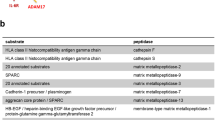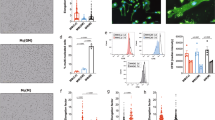Abstract
Two associated calcium-binding proteins (CaBPs) have recently been identified specifically in cells of myeloid origin. These proteins have relative molecular masses (Mr) of 8,000 and 14,000 and are variously referred to as the cystic fibrosis antigen1, the LI light chain2, MRP-8 (ref. 3) or p8, and the LI heavy chain2, MRP14 (ref. 3) or pi4, respectively. The expression of p8 and p14 seems to be confined to a specific stage of myeloid cell differentiation, because both proteins are expressed in circulating neutrophils and monocytes but not in normal tissue macrophages4,5. In chronic inflammatory conditions, however, such as rheumatoid arthritis, macrophages in affected tissues express both p8 and p14 (refs 4, 6, 7). These proteins are members of a family of CaBPs of low Mr (ref. 8), which include S-100 α and β proteins9,10, calcyclin (2A9)11, intestinal CaBP12 and p11 (ref. 13). All the proteins have an Mr of ∼10,000 with the exception of p14 which has a longer C-terminal sequence after the second calcium-binding domain. Little is known about their function, although by analogy with calmodulin they could be molecules involved in intracellular signalling that are activated by an increase in the intracellular Ca2+ concentration ([Ca2+]i) (ref. 14). Here we report that p14 is phos-phorylated in both monocytes and neutrophils. The level of p14 phosphorylation can be increased by elevating the [Ca2+]1 using the ionophore ionomycin, but is not affected by activation of protein kinase C using phorbol 12,13-dibutyrate. The phosphorylated residue is threonine at position 113, which is the penultimate amino acid in p14 and contained in the longer 'tail' sequence. Part of this sequence is identical15 to the neutrophil immobilizing factors NIF-1 and NIF-2 (ref. 16), indicating that the phosphorylation event could have a role in the generation of NIF activity in the p14 protein.
This is a preview of subscription content, access via your institution
Access options
Subscribe to this journal
Receive 51 print issues and online access
$199.00 per year
only $3.90 per issue
Buy this article
- Purchase on Springer Link
- Instant access to full article PDF
Prices may be subject to local taxes which are calculated during checkout
Similar content being viewed by others
References
Dorin, J. R. et al. Nature 326, 614–617 (1987).
Andersson, K. B. et al. Scand. J. Immunol. 28, 241–245 (1988).
Odink, K. et al. Nature 330, 80–82 (1987).
Zwaldo, G., Bruggen, J., Gerhards, G., Schlegel, R. & Sorg, C. Clin. exp. Immunol. 72, 510–515 (1988).
Hogg, N., Allen, C., & Edgeworth, J. Eur. J. Immun. 19, 1053–1061 (1989).
Hogg, N., Palmer, D. G. & Revell, P. A. Immunology 56, 663–681 (1985).
Palmer, D. G., Hogg, N., Allen, C. A., Highton, J. & Hessian P. A. Clin. Immun. Immunopath. 45, 17–28 (1987).
Rogers, J. Nature 339, 661–662 (1989).
Isobe, T. & Okuyama, T. Eur. J. Biochem. 89, 379–388 (1978).
Isobe, T. & Okuyama, T. Eur. J. Biochem. 116, 79–86 (1981).
Calabretta, B., Battini, R., Kaczmarek, L., de Riel, J. K. & Baserga, R. J. biol. Chem. 261, 12628–12632 (1986).
Fullmer, C. S. & Wasserman, R. H. J. biol. Chem. 256, 5669–5674 (1981).
Gerke, V. & Weber, K. EMBO J. 4, 2917–2920 (1985).
Kretsinger, R. H. CRC crit Rev. Biochem. 31, 119–174 (1980).
Freemont, P., Hogg, N. & Edgeworth, J. Nature 339, 516 (1989).
Watt, K. W. K., Brightman, I. L. & Goetzl, E. J. Immunology 48, 79–86 (1983).
Dale, I., Fagernol, M. K. & Naesgaard, I. Eur. J. Biochem. 134, 1–6 (1983).
Lagasse, E. & Clerc, R. G. Mol cell. Biol. 8, 2402–2410 (1988).
Hamilton, T. A. & Adams, D. O. Immun. Today 8, 151–158 (1987).
Murao, S., Collart, F. R. & Huberman, E. J. biol. Chem. 264, 8356–8360 (1989).
Dooley, D. C., Simpson, J. F. & Meryman, H. T. Exp. Hemat. 10, 591–599 (1982).
Haslett, C., Guthrie, L. A., Kopaniak, M. M., Johnston, R. B. & Henson, P. M. Am. J. Pathol. 119, 101–110 (1985).
Miller, L. J., Bainton, D. F., Borregard, N. & Springer, T. A. J. clin. Invest. 80, 535–544 (1987).
Anderson, N. G. & Anderson, N. L. Analyt Biochem. 85, 331–340 (1978).
Ackerman, S. K. & Douglas, S. D. J. Immun. 120, 1372–1374 (1978).
Higgins, R. C. & Dahmus, M. E. Analyt Biochem. 93, 257–261 (1979).
Davies A. A. et al. J. biol. Chem. 262, 10918–10921 (1987).
Author information
Authors and Affiliations
Rights and permissions
About this article
Cite this article
Edgeworth, J., Freemont, P. & Hogg, N. lonomycin-regulated phosphorylation of the myeloid calcium-binding protein p14. Nature 342, 189–192 (1989). https://doi.org/10.1038/342189a0
Received:
Accepted:
Issue Date:
DOI: https://doi.org/10.1038/342189a0
This article is cited by
-
Rewet without regret? Nutrient dynamics in fen peat exposed to different rewetting degrees
Biogeochemistry (2024)
-
Post-translational modifications on the metal-sequestering protein calprotectin
BioMetals (2023)
-
UPF1 regulates myeloid cell functions and S100A9 expression by the hnRNP E2/miRNA-328 balance
Scientific Reports (2016)
-
Leukocyte and serum S100A8/S100A9 expression reflects disease activity in ANCA-associated vasculitis and glomerulonephritis
Kidney International (2013)
-
S100 Calgranulins in inflammatory arthritis
Immunology & Cell Biology (2010)
Comments
By submitting a comment you agree to abide by our Terms and Community Guidelines. If you find something abusive or that does not comply with our terms or guidelines please flag it as inappropriate.



